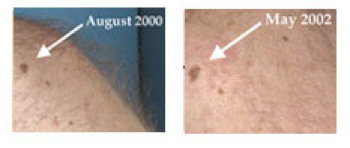Medical
Acne, also called acne vulgaris, is an inflammatory disease of the skin, caused by changes in the pilosebaceous units (skin structures consisting of a hair follicle and its associated sebaceous glad). Acne lesions are commonly referred to as pimples, spots, or zits.
Acne is a common skin condition in the United States. Dermatologists know that letting acne run its course is not always the best advice because without treatment dark spots and permanent scars can appear on the skin. Treating acne can increase self-esteem, and there are many treatments available.
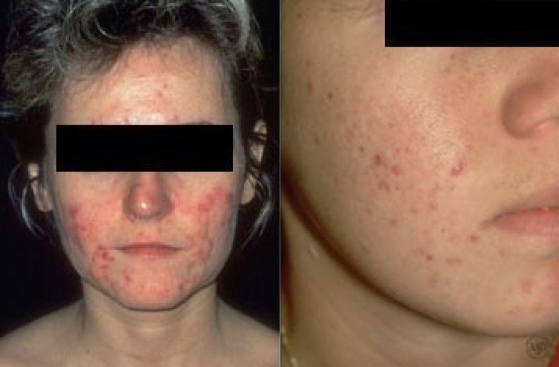
If you have questions or concerns about the best treatment options for your acne, please call to schedule an appointment with Dr. Harper, Katie Tuck, CRNP or Rebecca Edwards, CRNP to discuss treatment options. Call us at 205-978-3336
Dry Skin – Xeroderma literally means “dry skin”. It is a condition involving the integumentary system, which in most cases can safely be treated with emollients and/or moisturizers. Skin becomes dry when it loses too much water or oil. Xeroderma occurs most commonly on the lower legs, arms, the sides of the abdomen and thighs. Symptoms most associated with xeroderma are scaling (the visible peeling of the outer skin layer), itching and cracks in the skin. Our skin generally becomes dry as we age, during the winter and in low humidity climates.
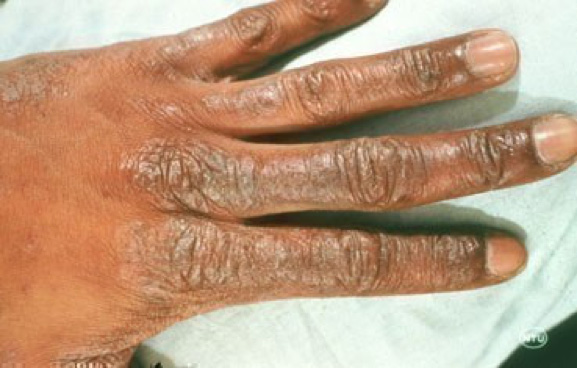
Eczema, Atopic Dermatitis, can be red, blistering, oozing, scaly, brownish, or thickened skin and usually itches. This often runs in families with allergies such as hay fever, asthma, sensitive skin or a history of atopic dermatitis. The skin rash can be very itchy and wide spread. The rash of eczema is different for each person. It may look different or affect different parts of your body from time to time. It is also known for its intense itch that can be so bad you scratch until your skin bleeds, which can make the rash worse.
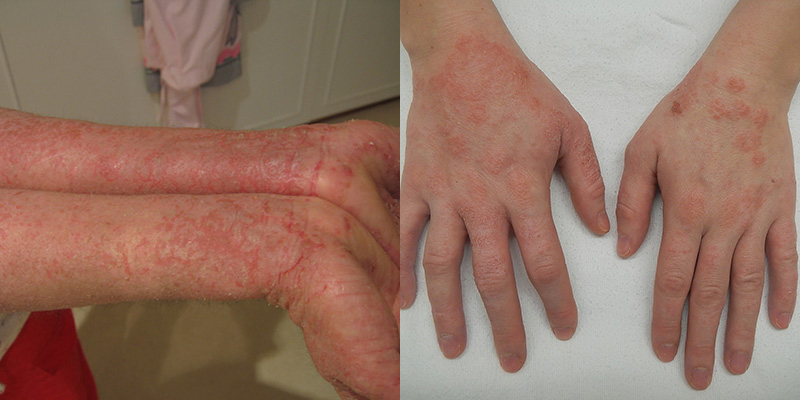
Keratosis Pilaris (KP) is a very common genetic follicular condition that is manifested by the appearance of rough bumps on the skin and hence colloquially referred to as “chicken skin”. It most often appears on the back and outer sides of the upper arms (though the lower arms can be affected), and it can also occur on the thighs and tops of legs, flanks, buttocks or any body part except glabrous skin (like palms or soles of feet). KP can also appear on the face and may be mistaken for acne. It can become itchy during the winter and low humidity climates. During the summer, the skin becomes less itchy and the bumps become less red.
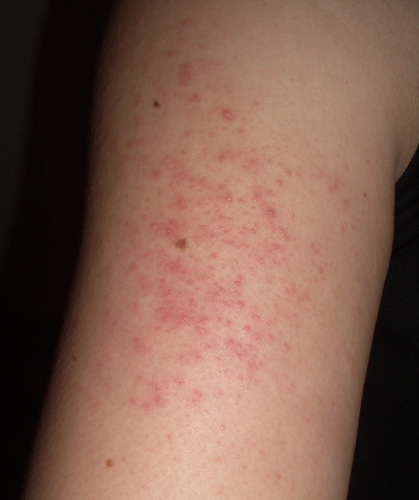
Psoriasis is a persistent skin disorder where red thickened aplaques of silvery scales most often appear on the body. Up to 30% of the people who have psoriasis may have symptoms of arthritis.
Psoriasis comes in many forms but they differ in severity, duration, location, shape and pattern of scales. Scalp, elbows, knees, legs, arms, genitals, nails, palms, and soles are the most affected areas for psoriasis. Scalp psoriasis may be mistaken for dandruff. Nails with psoriasis often have tiny pits in them.
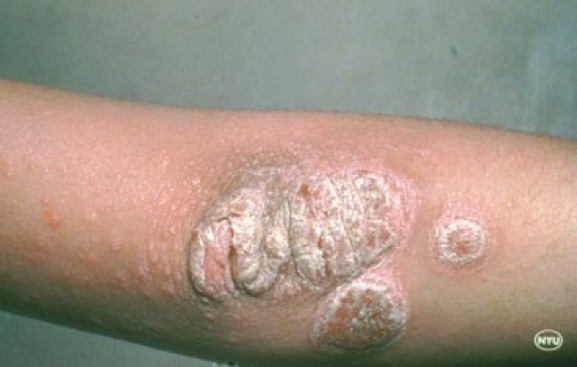
Rosacea is a common skin disease that causes pustules, redness, papules, and swelling on the face. Rosacea frequently begins as a tendency to blush easily or flush. Rosacea has four subtypes:
- Erythematotelangiectatic rosacea- redness, flushing, visible blood vessels.
- Papulopustular rosacea – redness, swelling, and acne-like breakouts.
- Phymatous rosacea – skin thickens and has bumpy texture.
- Ocular Rosacea- eyes red and irritated, eyelids can be swollen, and person may have what looks like a sty. About 50% of people with rosacea have ocular rosacea.
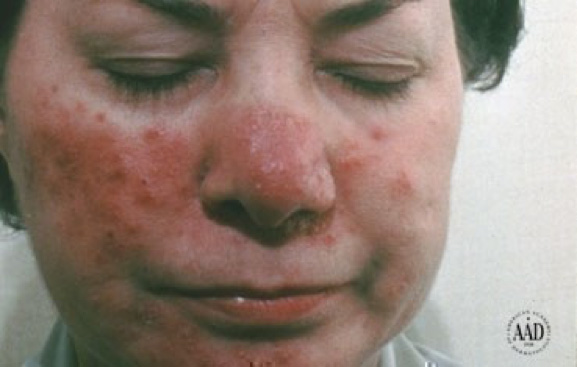
Skin cancer is a malignant growth on the skin, which can have many causes, including repeated severe sunburn or long-term exposure to the sun. Skin cancer generally develops in the epidermis, the outermost layer of skin, so a tumor is usually clearly visible. This makes most skin cancers detectable in the early stages. There are three common types of skin cancer each of which are named after the type of skin cell. In the case of UV damage, sun screen is one of the better forms of prevention.
- Atypical Nevus, also called dysplastic nevus, is not cancerous, but people who have these moles can be at a higher risk of making a melanoma.
- Actinic Keratosis is a precancerous lesion that appears as dry and scaly with a rough texture. It is easily treatable with liquid nitrogen or a topical cream. It can also be treated with Photodynamic Therapy (PDT). Actinic Keratosis left untreated can turn into a skin cancer called a Squamous Cell Carcinoma.
- Basal Cell Carcinoma is caused by chronic sun exposure and is the most common form of skin cancer. It can have several different appearances on the skin. It may look like an open sore, red patch, pink growth, shiny bump, or a scar.
- Squamous Cell Carcinoma is the second most common skin cancer. It has the appearance of a bump or red scaly patches. It can metastasize and spread to other parts of the body. Which is why it is important to get an early diagnosis and have it treated.
- The cure rate for Basal Cell and Squamous Cell Carcinoma is over 95% if diagnosed early and treated properly.
- Melanoma is the most deadly skin cancer. It can appear in mixed shades of tan, brown, and black, and it can also be red or white. Melanoma can metastasize and spread to other internal body areas. Melanoma can be excised while still in the early stages. Heredity also plays a part in developing melanoma.
The ABCDEs of Melanoma
A – Asymmetry
This benign mole is not asymmetrical. If you draw a line through the middle, the two sides will match, meaning it is symmetrical. If you draw a line through the malignant mole, the two halves will not match, meaning it is asymmetrical, a warning sign for melanoma.
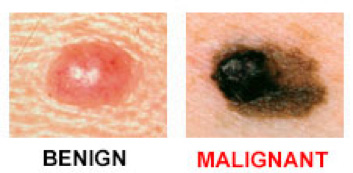
B – Border
A benign mole has smooth, even borders, unlike melanomas. The borders of an early melanoma tend to be uneven. The edges may be scalloped or notched.
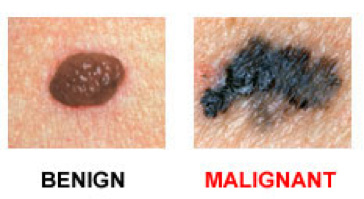
C – Color
Most benign moles are all one color — often a single shade of brown. Having a variety of colors is another warning signal. A number of different shades of brown, tan or black could appear. A melanoma may also become red, white or blue.
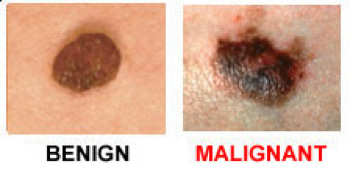
D – Diameter
Benign moles usually have a smaller diameter than malignant ones. Melanomas usually are larger in diameter than the eraser on your pencil tip (¼ inch or 6mm), but they may sometimes be smaller when first detected.
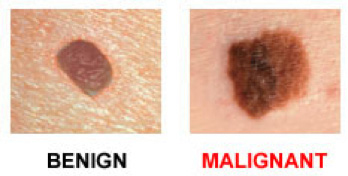
E – Evolving
Common, benign moles look the same over time. Be on the alert when a mole starts to evolve or change in any way. When a mole is evolving, see a doctor. Any change — in size, shape, color, elevation, or another trait, or any new symptom such as bleeding, itching or crusting — points to danger.
